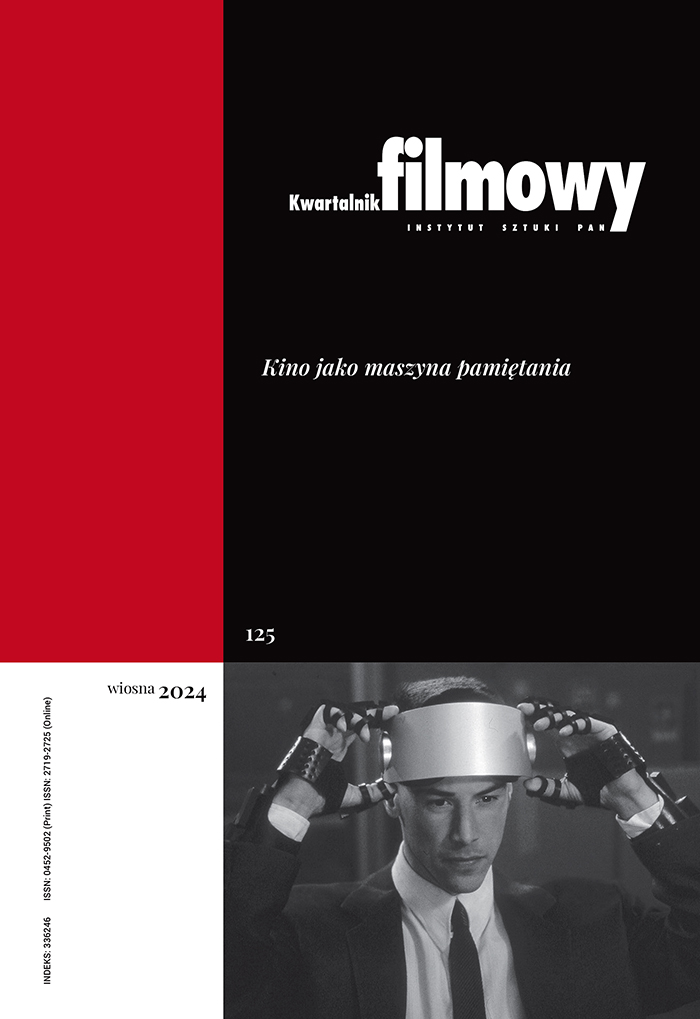Cyrano’s Letters, Desdemona’s Scarf and Phantom of the Opera’s Rose or the Movie Romance Props Room
Abstract
In theatre and cinema a prop belongs to the sign system: when appearing on a stage or screen, it means something, it communicates something by itself on literal, dramatic and symbolic levels. From the limitless collection of movie props the author picks only those linked with love. They are distinctively marked by two lovers. These props remain themselves - i.e. particular objects - but at the same time they turn into material vehicles of love, they help to create the dramatic tension, they symbolize the affection, substitute for desire, and embody lovers present (or not) on the screen. They can be divided into two categories: “good” - which support love, and “bad” - which destroy it, leading the lovers to impending doom. In this context Stachówna analyses certain romance props: a letter, a diary, flowers, clothes, jewels, photos, portraits, dishes and beverages. On the screen they turn into fetish, symbolizing what the movie characters - and the spectators, following their example - really crave for. They transfer the desire from the actual object of adoration - i.e. lover’s body - to something that is perceived with delight and touched without worry, letting us dispose of fears linked with sexuality. In cinema - and beyond - the romance props give a chance to maintain soothing balance and sense of security in personal and social dimensions.
Keywords:
props, fetish, symbolismReferences
Dzieje Tristana i Izoldy, wg Josepha Bédier, tłum. T. Żeleński (Boy), w: Pieśń o Rolandzie, Dzieje Tristana i Izoldy, François Villon Wielki testament, Państwowy Instytut Wydawniczy, Warszawa 1973, s. 158.
Google Scholar
Freud Sigmund, Fetyszyzm, tłum. M. Skrzypek, w: Charles de Brosses, O kulcie fetyszów, Polska Akademia Nauk, Warszawa 1992, s. 132-136.
Google Scholar
Freud Sigmund, Trzy rozprawy z teorii seksualnej (fragment), tłum. L. Jekels, M. Albiński, w: Charles de Brosses, O kulcie fetyszów, Polska Akademia Nauk, Warszawa 1992, s. 129.
Google Scholar
Hoffmann Krzysztof, Poezja. Fetysz teorii, „Podteksty” 2009, nr 3, http://www.podteksty.eu/index.php?action=dynamic&nr=18&dzial=4&id=388 (dostęp: 10.02.2011).
Google Scholar
Kijowski Andrzej T., Chwyt teatralny (Zarys instrumentalnej teorii teatru), Wydawnictwo Literackie, Kraków 1982, s. 34-56.
Google Scholar
Kowzan Tadeusz, Znak w teatrze, w: Wprowadzenie do nauki o teatrze, red. J. Degler, Wrocław 1976, t. 1, s. 314-315.
Google Scholar
Metz Christian, Pragnienie i jego brak, tłum. A. Helman, „Film na Świecie” 1989, nr 369, s. 23.
Google Scholar
Słownik wyrazów obcych, red. J. Tokarski, Państwowe Wydawnictwo Naukowe, Warszawa 1980.
Google Scholar
Authors
Grażyna Stachównakwartalnik.filmowy@ispan.pl
Jagiellonian University Poland
Profesor w Instytucie Sztuk Audiowizualnych Uniwersytetu Jagiellońskiego, historyk filmu. Prowadzi badania związane z historią filmu powszechnego oraz polskiego. Autorka m.in. dwu książek o twórczości Romana Polańskiego i dwu o melodramatach filmowych. Interesuje się kulturą popularną, jest wielbicielką kina indyjskiego (redakcja naukowa książki Nie tylko Bollywood /2009/ i numeru monograficznego „Studiów Filmoznawczych” Bollywood - prawdy i mity /nr 32, 2011/), a ostatnio serialu Lost: Zagubieni.
Statistics
Abstract views: 194PDF downloads: 129
License
Copyright (c) 2011 Grażyna Stachówna

This work is licensed under a Creative Commons Attribution 4.0 International License.
The author grants the publisher a royalty-free non-exclusive licence (CC BY 4.0) to use the article in Kwartalnik Filmowy, retains full copyright, and agrees to identify the work as first having been published in Kwartalnik Filmowy should it be published or used again (download licence agreement). The journal is published under the CC BY 4.0 licence. By submitting an article, the author agrees to make it available under this licence.
In issues from 105-106 (2019) to 119 (2022) all articles were published under the CC BY-NC-ND 4.0 licence. During this period the authors granted a royalty-free non-exclusive licence (CC BY-ND 4.0) to use their article in „Kwartalnik Filmowy”, retained full copyright, and agreed to identify the work as first having been published in our journal should it be published or used again.
Most read articles by the same author(s)
- Grażyna Stachówna, Alice Doesn’t Live Here Anymore... , Kwartalnik Filmowy: No. 113 (2021): Film and Technology
- Grażyna Stachówna, Żuławski in Grand Guignol , Kwartalnik Filmowy: No. 95 (2016): Transnational Dimension of Polish Cinema
- Grażyna Stachówna, My Debut in “Kwartalnik” , Kwartalnik Filmowy: No. 100 (2017): On Celebrating
- Grażyna Stachówna, The Protei of the Cinema: The Body as a Tool and Means of Artistic Endeavour , Kwartalnik Filmowy: No. 83-84 (2013): Body in Film
- Grażyna Stachówna, Gérard Philipe, or the Key to Recollections , Kwartalnik Filmowy: No. 37-38 (2002): Actor and Film Character
- Grażyna Stachówna, Citizen Kutz – The Silesian Gelender , Kwartalnik Filmowy: No. 75-76 (2011): Faces of Reality
- Grażyna Stachówna, Renewal of the Formula: Melodrama of the End of the Century , Kwartalnik Filmowy: No. 34 (2001): Cinema at the Turn of the Century
- Grażyna Stachówna, Elizabeth I – A Woman and Queen , Kwartalnik Filmowy: No. 45 (2004): Sacrum in Film











